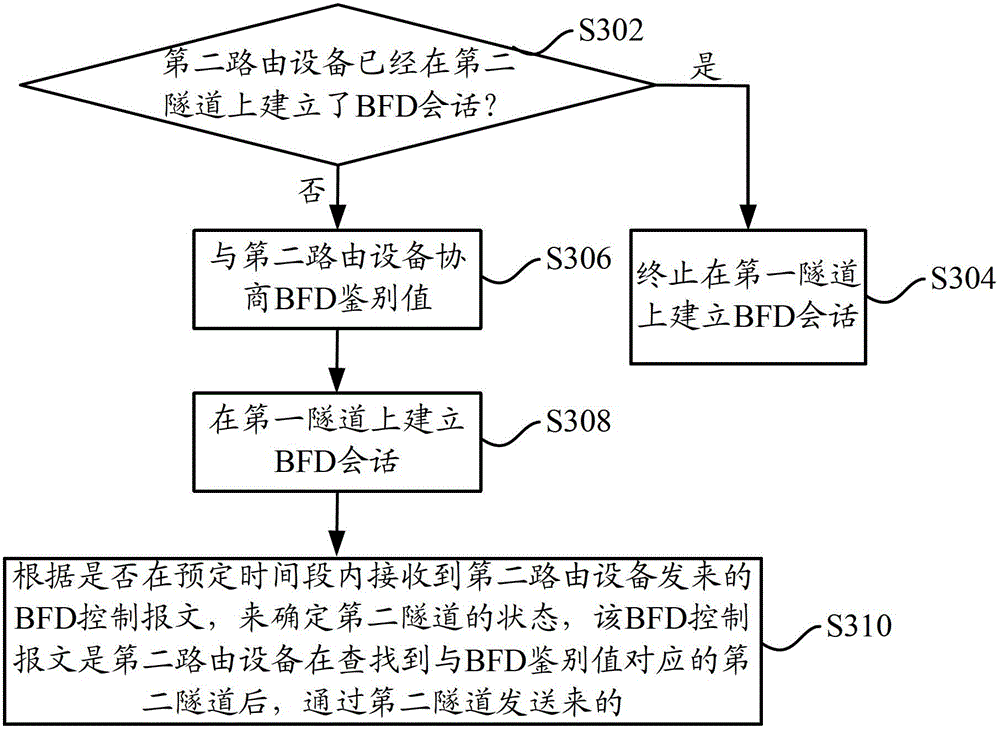Bi-directional forwarding detection (BFD) method of multiple protocol label switching (MPLS) traffic engineering (TE) bi-directional tunnel and routing equipment
A detection method, a technology of two-way forwarding detection, applied in the direction of data exchange through path configuration, digital transmission system, electrical components, etc., can solve problems such as false positives, waste of BFD session resources, etc.
- Summary
- Abstract
- Description
- Claims
- Application Information
AI Technical Summary
Problems solved by technology
Method used
Image
Examples
Embodiment 1
[0023] in such as figure 2 In the shown network of MPLS TE bidirectional tunnels, the MPLS TE tunnel from the first routing device to the second routing device (called the first tunnel) is configured on the first routing device, and the second routing device is configured on the second routing device. Device → MPLS TE tunnel of the first routing device (called the second tunnel), the first tunnel and the second tunnel form a pair of MPLS TE bidirectional tunnels. Wherein, the routing device may be a router, or a routing switch, etc., which is not limited in the present invention.
[0024] It should be noted that the first routing device and the second routing device do not specifically refer to a certain routing device, the first routing device can be any routing device in the network, and the second routing device can be any A routing device with an MPLS TE bidirectional tunnel established between devices.
[0025] like image 3 as shown, figure 2 When the first routing...
Embodiment 2
[0050] like Figure 4 as shown, figure 2 In the first routing device as a passive end, when no BFD session is established in the second tunnel, the BFD detection method of the MPLS TE bidirectional tunnel includes the following steps:
[0051] Step S402, the first routing device negotiates the BFD authentication value with the second routing device as the active end;
[0052] At this time, before the second routing device as the active end conducts BFD authentication value negotiation with the first routing device as the passive end, the operations of the second routing device are the same as steps S302 to S304 in Embodiment 1, which will not be repeated here.
[0053] The specific negotiation process can be as follows:
[0054] Step 1, the first routing device receives the MPLS RSVP-LSP ping message sent by the second routing device;
[0055] Step 2, the first routing device judges whether the MPLS RSVP-LSP ping message carries the identifier of the first tunnel (the method...
Embodiment 3
[0061] In the third embodiment, the routing device is a router, such as Figure 5 As shown in the figure, TunnelA is configured on RouterA, and TunnelB is configured on RouterB. TunnelA and TunnelB form a group of MPLS TE bidirectional tunnels. In this embodiment, the procedure for RouterA and RouterB to perform BFD detection on the MPLS TE bidirectional tunnel may be as follows:
[0062] When RouterA intends to enable BFD (mplste bfd enable) on TunnelA, it judges whether it is a bidirectional tunnel (that is, judges whether TunnelA has a bidirectional tunnel binding relationship with other tunnels), and if it is not a bidirectional tunnel, handle it according to the existing technology; If it is a bidirectional tunnel, first check whether there is a BFD authentication value corresponding to the ID of TunnelA (recorded as TunnelA ID). There are two cases 1) and 2) below:
[0063] 1) If the BFD authentication value corresponding to the ID of TunnelA is not found, it means that...
PUM
 Login to View More
Login to View More Abstract
Description
Claims
Application Information
 Login to View More
Login to View More - R&D
- Intellectual Property
- Life Sciences
- Materials
- Tech Scout
- Unparalleled Data Quality
- Higher Quality Content
- 60% Fewer Hallucinations
Browse by: Latest US Patents, China's latest patents, Technical Efficacy Thesaurus, Application Domain, Technology Topic, Popular Technical Reports.
© 2025 PatSnap. All rights reserved.Legal|Privacy policy|Modern Slavery Act Transparency Statement|Sitemap|About US| Contact US: help@patsnap.com



